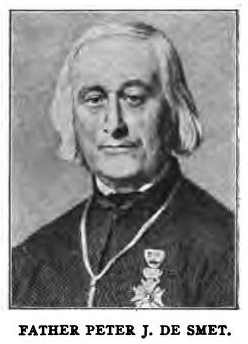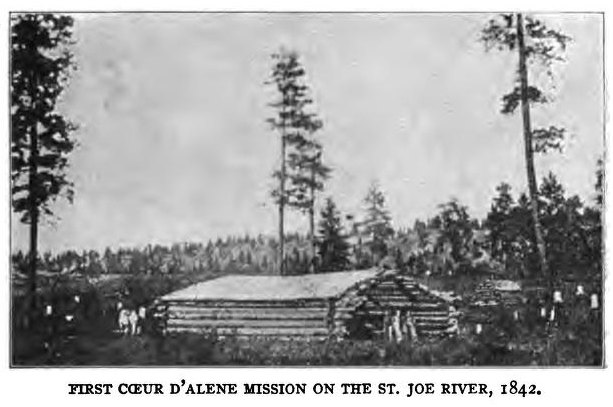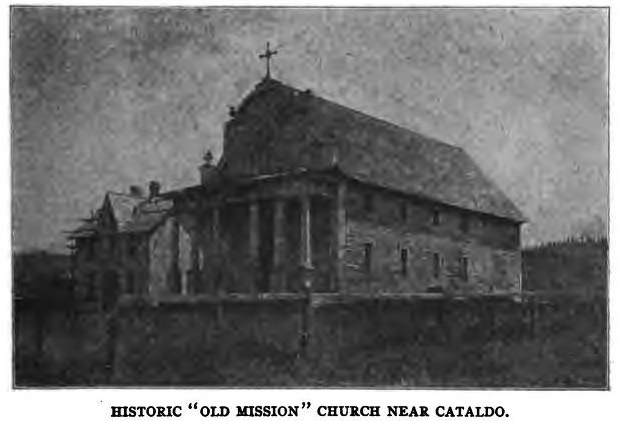The Catholic Missions
Abstracted from "History of the State of Idaho," by Cornelis J. Brosnan, published by Charles Scribner's Sons, 1918; p. 74f. archive.org
The Catholic Missions.—The next missionaries to enter the future Idaho were representatives of the Jesuit order of the Catholic Church. Between the years 1812 and 182o a small band of Iroquois Indians from eastern Canada had penetrated the country of the Flathead Indians situated in what is now western Montana. They were Catholics and their presence aroused an interest in their faith among the Flatheads. Between 1831 and 1839 four deputations were sent to St. Louis by these Flatheads, requesting that the Catholic missionaries be sent among them. It was in response to these appeals that the Catholic Church at St. Louis authorized the establishment of Catholic missions in the Oregon country in 1840.

Father Peter J. De Smet. —The missionary selected to evangelize the Flatheads and other Rocky Mountain tribes was Father Peter J. De Smet. A native of Belgium and connected with St. Louis University since 1829, he was destined during the period lying between 1840 and 1863 to make five journeys to the Oregon country. After 1850 Father De Smet became an international figure on account of his writings and his extraordinary ability as a pacificator of hostile Indian tribes. At the urgent request of the government Father De Smet journeyed to Oregon in 1858 to pacify the hostile Yakimas. In 1863 he made his last visit to this region. His important missionary labors in the Pacific Northwest were accomplished, however, in that charming decade lying between 1840 and 1850, when the spirit of adventure and romance still brooded over the Empire of the Red Man.
Father De Smet's Visits to Southern Idaho.—Father De Smet visited southeastern Idaho during the summers of 1840 and 1841. In July, 1840, while making his first missionary journey to the Flathead country, he conducted religious services in the beautiful Teton Basin, in Teton County, then known as Pierre's Hole. In this valley, so famous in the annals of the fur trade, he preached to 1,600 Flatheads and Pend d'Oreilles. These Indians had made the long journey to the southern Idaho country to escort the "Black Robe" to their northern homes.
In 1841, accompanied by Fathers Nicholas Point and Gregory Mengarini, Father De Smet made his second and last journey through southern Idaho. A lively incident of this expedition was the visit of the missionary to Old Fort Hall. While scarcely seven years had passed since the erection of this post by Wyeth, yet it had already assumed the dual role of trading-post and hostelry. In a letter written at the fort under date of August 16, 1841, Father De Smet pays a tribute of appreciation to his host, Francis Ermatinger, the chief trader in charge at the fort who was himself an Episcopalian. This generous official of the Hudson's Bay Company made Father De Smet an honored guest at his table, sold him supplies at one third of the usual cost, and donated outright numerous articles in the way of provisions and equipment.
Father De Smet in North Idaho.—As north Idaho lay directly between Father De Smet's missionary field in Montana and the scenes of his visits to the modern States of Oregon and Washington, he had occasion to cross and recross our future "Panhandle" many times. His favorite routes followed the river and along the south shore of Lake Coeur d'Alene or skirted the northern end of Lake Pend d'Oreille.
Father De Smet's Activities Among North Idaho Tribes.—While Father De Smet's North Idaho travels lay within the country of the Pend d'Oreille and Coeur d'Alene Indians, yet he succeeded in evangelizing large numbers of Kutenais and Nez Perces who often sent delegations to meet him. While returning to Montana from St. Paul's Mission in the Willamette Valley in the summer of 1842 he visited the Coeur d'Alenes. Their appeals for a resident missionary were so insistent that Father De Smet decided to send "Black Robes" to them during the following autumn.

The Establishment of the First Coeur d'Alene Mission. — Father Nicholas Point and Brother Charles. Huet were the missionaries detailed by Father De Smet to establish a permanent mission among the Coeur d'Alenes. The site selected for the first mission chapel was on the north bank of the Saint Joe River, about one mile from the southern end of Lake Coeur d'Alene. The location, a beautiful one in the summer and autumn, was inundated by the river floods every spring; so in 1846 the mission was moved to the vicinity of the present town of Cataldo on the Coeur d'Alene River.
The Second or "Old " Mission on the Coeur d'Alene River (1846).—In 1847, the year following the arrival of the missionaries in their new home, they began the erection of the famous "Old Mission" Church. While services were held in the new structure as early as 1848, the details of its construction were not completed until the year 1868.
It was designed by Father Anthony Ravalli, and was 90 feet long, 35 feet wide, and 30 feet high. A portico, supported by six massive wooden pillars, added to the attractiveness of the historic edifice An interesting feature associated with the construction of the church was the fact that wooden pins were substituted for nails and no metal whatever was used in the walls of the structure. This "Old Mission" Church was Idaho's first Catholic house of worship. Thanks to the faithful workmanship of the fathers, brothers, and Indians who reared its historic walls, it still continues in an almost perfect state of preservation.
A Romantic History.—In 1853, Isaac I. Stephens the great Territorial governor of Washington, shared the hospitality of the Sacred Heart Mission and has recorded a tribute to the architectural beauty of its church. A few years later, in 1858, that "blood and iron" warrior, Colonel George Wright, journeyed to this scene and held solemn conclave with the Coeur d'Alenes. In the same year, Captain John Mullan, intent on building the wagon road which bears his name, was an honored guest at the mission, and called it "a St. Bernard in the Coeur d'Alene Mountains." From November, 1858, until February, 1859, it sheltered its founder, Father Peter J. De Smet.

During the eventful history of "Old Mission" its lights have gleamed a welcome to the red man, the explorer, the engineer, the soldier, the packer, the hunter, and the prospector. Its walls have echoed to the fiery oratory of Indian chief, the solemn chant of sacred music, the sounds of joyous revelry, and in recent years, the rifle crack of labor warfare.
The De Smet Mission.—In 1877 the mission was removed from its picturesque home on the banks of the Coeur d'Alene River to the fertile Hangman Valley in the present Benewah County. Here the Jesuits have continued their labors to the present day. The mission post office is located at the village of De Smet. This little town, so appropriately named, perpetuates the fame of the beloved pacificator, the talented writer, and the " Great Black Robe," who, indifferent to ecclesiastical honors, ministered "beside the death–bed of a race."
American History and Genealogy Project
Webspace for this site is generously provided by Genealogy Village and Access Genealogy
Copyright © 2013 - Sharon McConnel. All Rights Reserved.
